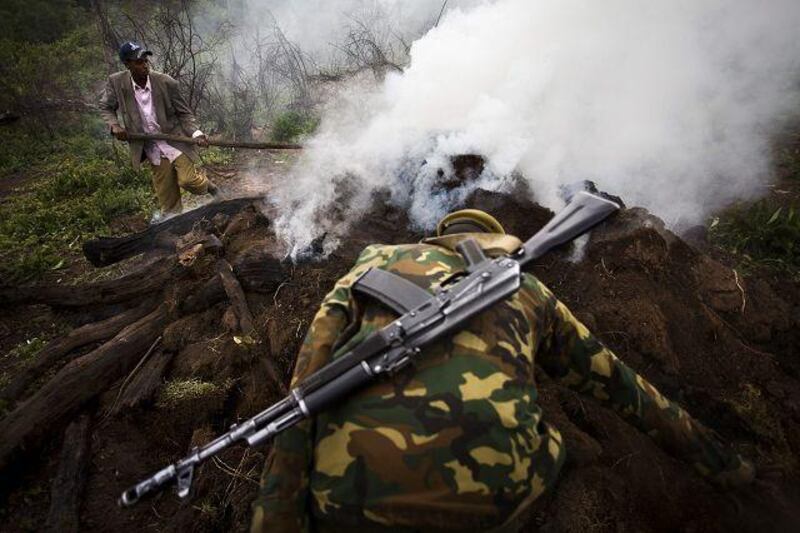MAU FOREST, Kenya // Wisps of white smoke waft from a mound of earth. John Ewaton, a Kenya Wildlife Service ranger, is busy kicking holes in the dirt heap to reveal smouldering cedar branches. It takes about two weeks to build a charcoal kiln like this one, and Mr Ewaton has destroyed it in 15 minutes. A gust of wind catches the exposed tinder and the wood bursts into flames. In a few minutes, the logs are reduced to ash, destroying charcoal worth US$100 (Dh367). The charcoal trade is a big business for settlers living in the Mau Forest in south-western Kenya. But it is also contributing to one of the worst environmental disasters in east Africa. Rangers such as Mr Ewaton arrest charcoal-makers and destroy the kilns that have turned this particular swathe of forest into a charred wasteland where blackened tree stumps poke through a cover of green ferns. "We are trying to disrupt the charcoal-makers so that they can't get the charcoal to sell," Mr Ewaton said. "The person that made this one, he will know that we were here and he won't come back and try again." Charcoal-making, illicit logging of the hardwood podocarpus trees and encroachment from farmers squatting on the land illegally have combined to destroy one-fourth of the 400,000-hectare Mau Forest, the largest indigenous forest in east Africa and an important watershed. "The excisions and the widespread encroachments have led to the destruction of nearly one-quarter of the Mau complex area over the last 15 years," Raila Odinga, the Kenyan prime minister, said in a speech to environmentalists. "Such an extensive and ongoing destruction of a key natural asset for the country is nothing less than a national emergency." Twelve rivers originate in the Mau Forest, including the Mara River, which traverses the Masai Mara game park, and several rivers that drain into Lake Victoria, the source of the Nile River. An estimated 10 million people rely on water from the Mau watershed and the destruction of the forest has already created drought-like conditions for farmers and pastoralists in the region. A 60-megawatt hydroelectric project on one of the Mau Forest rivers has been delayed because water flows are too low to turn the turbines. The United Nations Environmental Programme estimated that Kenya will lose $300 million in the tourism, energy and agricultural sectors if the forest is wiped out. The Ogiek people, a hunter-gatherer tribe, traditionally lived sustainably in the forest. In the past 15 years, politicians gave forest land to farmers to win votes. Then the real destruction began. "The forest is in a very fertile region where there is valuable land for agriculture," said Jackson Bambo, a project officer with Kenya Forest Working Group, a consortium of environmentalists trying to save Kenya's forests. "Politicians grabbed land to give to people. In return, they got votes. It is very political." The Forest Act of 2005 protected the Mau Forest and prevented politicians from parcelling it out, but 30,000 settlers remained, many of them illegally. Only about 1,500 farmers in the forest have deeds to their land. The rest are simply squatters. Mr Odinga set up a task force last year to solve the problem of deforestation. The task force recommended evicting the squatters and resettling them on land outside the forest. Kenya Wildlife Service and other agencies were tasked with patrolling the forest for illegal activities. "The government is saying these people are going to be resettled after they are given land somewhere," said Tuqa Jirmo, the head wildlife warden in charge of protecting Mau Forest. "Most probably we won't forcefully evict people. We won't use military force." From a ridgetop overlooking a large section of the Mau complex, the forest looks patchy and is thinning in places. A patchwork of maize and bean fields is interspersed among the sparse tree cover. Farmers on this land say the government has told them to leave, but has not provided them with new land. Steve Kiplangat, 30, has farmed maize and potatoes on his plot for the past 10 years. He lives in an area of the forest known as Sierra Leone because much of the land was given to Kenyan soldiers who served as peacekeepers in that country a decade ago. "I feel very bad because I don't have anywhere to go," he said. "The government better give us a place to live if they want us to leave here." Joseph Kituri has been on his small hilltop potato farm for all of his 58 years. Even though he legally owns his land, he has been lumped in with the other squatters and told to leave the land for the health of the forest. Until five years ago, the surrounding hills were covered in trees, he said. Now the forest is a faint dark line on the horizon. "It used to be like that," Mr Kituri said, pointing to the far off forest. "Then people came and slashed all the trees." mbrown@thenational.ae
Forest turning into charred wasteland
Rapid encroachment by illegal squatters and charcoal-makers is causing one of the worst natural disasters in east Africa.

Editor's picks
More from the national




